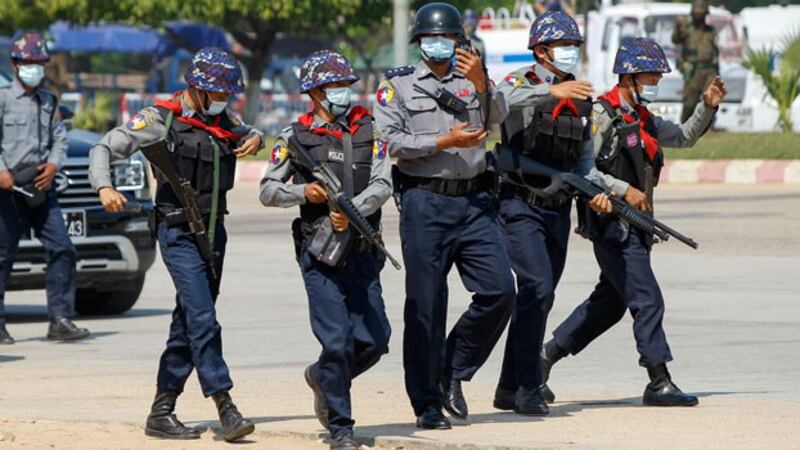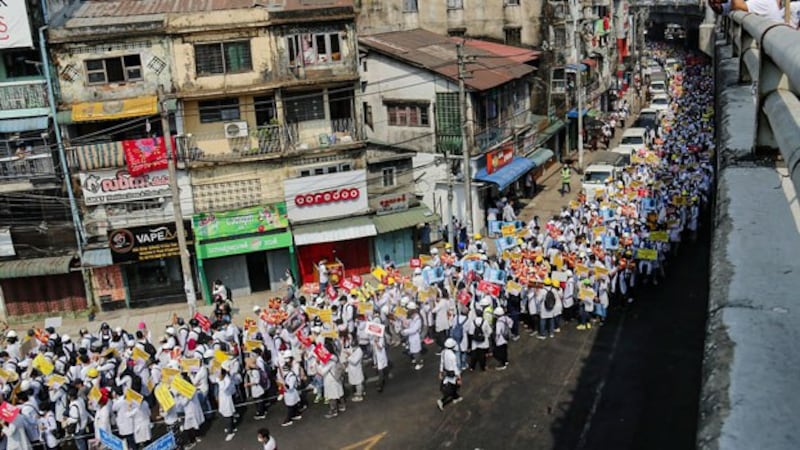UPDATED at 4:45 P.M. EST on 02-22-2021
Hundreds of thousands of protesters took to the streets of major cities across Myanmar Monday for an all-day nationwide strike in defiance of a warning by the three-week-old military regime that further demonstrations could lead to “loss of life.”
The “22222 Popular Uprising” — drawing on the digits in 2/22/2021 — of mass strikes and demonstrations came exactly three weeks since the army deposed civilian leader Aung San Suu Kyi and her elected government. In weeks of daily protests, three protesters and a night watchman have been shot dead by security forces.
Protesters rallied despite bans on public gatherings of more than five people, and amid an internet service blackout in Myanmar’s largest city, Yangon, from 1 a.m. to noon on Monday.
Military convoys entered major residential areas of Yangon and set up blockades on streets of foreign embassies and at the local United Nations office, where demonstrations have been held.
The deployments came after the military on late Sunday warned on state television and via loudspeakers on patrol trucks of a “loss of life” if the protests continue.
“It is found that the protesters have raised their incitement towards riot and anarchy mob on the day of 22 February,” the Associated Press quoted the English text that appeared on screen. “Protesters are now inciting the people, especially emotional teenagers and youths, to a confrontation path where they will suffer the loss of life.”
State-run MRTV warned local media outlets not to use the words “coup” or “power-seizing government” in Burmese or they would face legal action, including shutdowns. MRTV and the junta’s webpage have both been banned from Facebook, which millions of people in Myanmar use as their primary source of news and information.
On Monday morning, however, huge crowds moved past trucks blocking the roads and rallied at Yangon’s Sule Pagoda and at the Hledan and Myae Ni Gone junctions — historic protest sites from the “8888 Uprising” when students launched a nationwide movement against decades of entrenched military rule on Aug. 8, 1988, that was crushed by the army with thousands killed.

'Flagrant interference'
Myanmar’s Foreign Ministry, under junta control, issued a statement Monday slamming widespread foreign criticism of the killings — which came from the United Nations, Western countries, but also Japan and Singapore — as “tantamount to flagrant interference in internal affairs of Myanmar.”
The State Administration Council, as the military regime formally calls itself, is “exerting utmost efforts for peace, stability, unity and [the] socioeconomic development of the country and people,” the statement said.
“Despite facing the unlawful demonstrations, incitements of unrest and violence, the authorities concerned are exercising utmost restraint through minimum use of force to address the disturbances in order to maintain rule of law and public safety in line with domestic laws and international practices,” it said.
On Monday, U.N. Secretary-General António Guterres condemned the military takeover and called for the release of all detainees in remarks to the U.N. Human Rights Council in Geneva.
“We see the undermining of democracy, the use of brutal force, arbitrary arrests, repression in all its manifestations. Restrictions of civic space. Attacks on civil society,” he said.
“Today, I call on the Myanmar military to stop the repression immediately. Release the prisoners. End the violence. Respect human rights, and the will of the people expressed in recent elections,” added Guterres.
Japan, an important investor and aid donor to Myanmar that is normally muted in its criticism of Naypyidaw, took issue with the killings.
”Use of force employing guns against a peaceful demonstration is unacceptable,” Japanese Foreign Ministry spokesman Tomoyuki Yoshida said Sunday. He called for an ”immediate stop” to violence and the release of Aung San Suu Kyi and others held since the coup.

Police chase protesters, reporters
In Mandalay, Myanmar's second-largest city where two protesters were shot dead by security forces on Saturday, hundreds of thousands of people demonstrated in the streets against the regime, watched over by a large group of security personnel outside the regional High Court and the central railway station, though no incidents were reported.
Close to a million students, government employees, and residents marched against the junta in the Naypyidaw capital area, with the main column of about 100,000 people holding a 30-minute sit-in in an outlying township. Earlier in the day, police barricaded the main thoroughfare leading to the roundabout in the capital that was the scene of huge rallies for weeks.
Five police mini-trucks, one military truck, and two prison vans arrived at the scene and dispersed the crowd with water cannons. Security forces chased those who ran away make arrests, protesters said. Police officers also chased down reporters and seized cash and property from protesters.
“We were holding our peaceful protest when the police came in force from behind, and we ran away from the scene,” said one protester. “After they passed by, we regrouped to continue our protests, but we were chased away again.”
More than 100 protesters were arrested by security personnel in Pyinmana, the most populous town close to the capital, demonstrators said.
“People scattered and ran into nearby streets, but the security forces chased them down even in small alleys,” said another protester.
“So far, we’ve heard that there were more than 100 people who were rounded up and taken away in the trucks and prison vans.”
A military officer was heard giving orders to arrest those who videoed the actions and to confiscate the cameras and all the reporters, said one journalist who declined to be named for safety reasons.
“We had to run when the police started coming for us,” he said, adding that he tripped and fell when running away and a young boy helped him into a nearby shop and shut the doors.
“I can’t walk properly now, [and] I cannot go to a clinic,” he said. “Some of my fellow reporters sent me home.”
Police also took away some motorcycles and cars parked near the rally site, witnesses said.
“When the police approached one car, the driver put down the windows fearing they might break them, and he was violently pulled out of the car and taken away,” said a young protester.
“And that point, my three brothers and I took our motorbikes and rode away from the scene. I heard six other cars were also taken away,” he said.

Rallies in other towns
Other mass demonstrations were held in the towns of Pathein in Ayeyarwady region, Myaing and Sinphyukyun in Magway region, and Lashio in northern Shan state, the last of which had a protest attended by about 100,000 people. No incidents were reported at the demonstrations.
In Magway, all shops, restaurants, and shopping malls were closed, and entire families along with civil servants, monks, and farmers took part in an anti-military march. There were no incidents, although most of the main roads were closed down by the police.
“Just look at the hundreds of thousands of people on the roads taking part in these protests throughout the country,” said a resident of Pwintphyu in Magway region. “The whole world should realize by now that it is totally impossible we had fraudulent elections as the military council had announced.”
People from villages surrounding the ancient city of Bagan gathered for a protest that numbered up to 100,000.
Similar mass “22222” anti-coup protest marches were held in the regional cities of Myitkyina, Mawlamyine, Loikaw, and Hpa-an as well as in small towns across the country of 54 million.
Meanwhile, the Committee Representing Pyihtaungsu Hluttaw (CRPH), a shadow parliament formed by lawmakers elected in the November 2020 vote that the junta claims was marred by fraud, urged the public to form 11-member community-based civil administration committees in every township to defend themselves and defy military rule.
“We have been preparing for the last two days to have our own administration teams in each township ward of the township,” said Kyi Pyar, a former lawmaker representing Yangon’s Kyauktada township constituency.
Newly appointed ward administrators have been rejected by residents in some townships in Yangon, she said.
“We are now working in various townships according to guidelines from regional officials,” she said.
Min Zeyar, vice chairman of People’s Party, said residents in each ward are devising security plans for themselves to ensure they have peace in their communities.
“The CRPH has supported this, and people are waiting for guidelines and suggestions on how to carry out the work,” he said.
A resident of North Dagon township on the east side of Yangon said ordinary people are fearful because they cannot rely on the police for security.
“The problem is the disruption of the civil administration machinery,” he said. “We do not and cannot trust anyone. I hear they are now trying to form security teams like local militias, but I don’t know if they have really been formed.”
The Assistance Association for Political Prisoners, a watchdog group, said that as of Saturday, 640 people had been arrested, charged, or sentenced in relation to the military coup, with 593 still being held.
Reported by RFA’s Myanmar Service. Translated by Khin Maung Nyane. Written in English by Roseanne Gerin.
